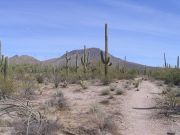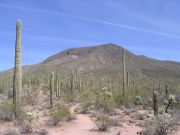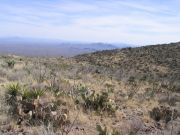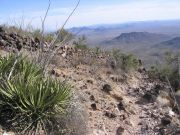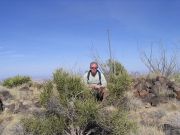
The Mountains of Arizona
• www.surgent.net
|
| Table Top |
• Highpoint: Table Top Mountains • Sonoran Desert National Monument • Pinal County |
|
Date: March 25, 2006
• Elevation: 4,373 feet
• Prominence: 2,333 feet
• Distance: 8 miles
• Time: 8 hours
• Gain: 2,400 feet
• Conditions: Hot, with snakes
Table Top is a distinct peak, so named for its flat "table" top. The peak lies about 25 miles southwest of Casa Grande, south of Interstate-8 at the Vekol Valley Road exit. It is visible from just about any point within 50 miles, and on clear days, it is visible from the hilltops around Tempe and Phoenix.
There is a good trail that leads to a slightly-lower southern summit. Along the way, the trail meanders through low-desert scrub and cactus, then steep, boulder-strewn paths high on the mountain. Nearer the top, old stone walls run alongside the trail for many hundreds of feet. The walls are about 3 to 6 feet high and are fitted together naturally with no mortar. Who built them and why is still a mostly-unsolved mystery.
In recent years, the surrounding region has become a main corridor for drug-smuggling coming in from Mexico. The peak is about 70 miles north of the border, but immediately south is the Tohono O'odham Indian Reservation, which is covered in roads and allows smugglers nearly unlimited options to make their way north. We headed there fully aware of this fact. However, deaths or other violent interactions of civilians by these smugglers is essentially zero. We'd have a better chance of getting shot (or worse) by standing around 16th Street and Broadway in Phoenix on a Saturday night.
From our home, we drove south through Maricopa and the Ak Chin Indian Community to State Route AZ-84 at Stanfield, then from there to Interstate-8. Another twenty miles or so, we exited at the Vekol Valley Road, then rumbled south for about 13 miles through desert scrub and burned-out buildings. The road was rough, with a lot of ruts, but not terribly bad. We arrived at the small camping area at the end of the road in an hour. The campground consists of three spaces and a vault toilet. Surprisingly, one other spot was taken. The night was mild. She slept in the truck's cab while I slept on the ground under the stars.
The next morning we sat around camp for awhile. The other campers left, while a couple of day visitors showed up and started in on their hikes. We started our hike at 10 a.m. in warm weather. The trail starts at the end of the road, where a fence and 4 sturdy stumps bar traffic from proceeding. This is the wilderness boundary. The trailhead's elevation here is slightly under 2,300 feet. The first half-mile is the old road, which trends northeast and comes to a sign marking the trailhead and a register, this presumably being the older trailhead.
The first two miles of trail past the second trailhead are easy, as the trail works its way up and down a series of hills and washes, with Table Top's big mass ahead of us to the northeast. This was classic Sonoran Desert landscape, with sandy and rocky soils, saguaro cactus as well as the full range of other common cacti including cholla, plus woodier plants such as ocotillo and palo verde. We had gained about 500 feet elevation in these two miles. We took a rest here.
Resuming our trek, we started up steeper and rockier slopes. The first portion gained moderately steeply and switchbacked a number of times to come to a sharp bend on Table Top's west face. The trail turned right, dropped about 20 feet into a drainage then started up the other side, now on the peak's southwest slopes. We took another break a few switchbacks up, then started up the heftiest part of the route. The switchbacks hug a talus field of black basalt volcanic rock, then start a gruelingly steep, tightly-switchbacked portion that took the wind out of our sails that slowed us. The trail-builders did a fine job etching in a trail here. We kept at this and in time, stumbled onto gentler slopes approaching the southern (lower) summit at 4,356 feet.
Now above the steep slopes and approaching the southern, lower summit, we saw for the first time these curious walls that line the trail. They are quite interesting to look at, obviously begging the question of their origin and purpose. It certainly wasn't a trivial task to assemble these walls. Some come right up to the side of the trail.
We arrived to the lower summit, marked by a wooden post. The range highpoint was across the flat plateau a few hundred yards north. The day was warm and we were lagging due to the heat. Later, we would learn that the nation's highest temperature for today was over in Gila Bend, a shade under 90 degrees. That's kind of warm this time of year. The black volcanic rock radiates the heat well, adding to the overall heat effect. So yes, we were a little more drained than usual.
The actual summit is a mere 17 feet higher, about a half-mile to the northeast, and sits atop a rise of the broad summit plateau. We went the long way, around the "horseshoe" shape of the ridge, following some paths in parts and going cross-country in other parts to the top. We took our photos but didn't spend too much time here. Two metal poles stuck up out of the presumed summit rocks, but we tagged a couple other rock piles just to be sure.
When we hiked back to the first summit, βð followed a more direct route and actually found an encampment used by the Mexican crossers. This one seemed to be freshly stocked, but no one was around. It's very likely these were lookouts, and they were laying low from us, probably hiding somewhere amid the rocks and brush. We knew we were being watched. We took a GPS reading here, logging its coordinates. Back at the lower summit, we took a rest before starting down the steep slopes.
Her ankles and knees were both giving her a hard time and she had to go slowly. We covered the portion to the desert flats in 90 minutes, now about 6 in the evening. The remaining two miles were a lot easier since the trail was smoother and not as steep. As we approached the truck in the dusky sunlight, I spooked a big rattlesnake. He coiled and shook his rattler, ready for action about 10 feet from me. I steered clear of him and directed βð around him too. Back to the truck, we piled in, got some cold drinks from the cooler, and started driving out, trying to beat the darkness as best we could.
We got about halfway back toward the interstate, and by now it was black, when two sets of headlights just "appear" in my rear-view mirror, coming at us fast. I pulled over and so did they, they being two Border Patrol vehicles. They questioned us, inspected my truck for contraband and people, and gave me a long song-and-dance about the danger of this region, how lucky I am, things like that.
Since they had us pulled over, we thought we'd tell them of the encampment we found up near the lower summit. We offered them the GPS coordinates, but to our surprise, they weren't interested. Fifteen minutes passed before they let us go, giving us about twelve more warnings about the area.
So we drive north and not five miles later, within a mile of the interstate, we got pulled over again by another Border Patrol guy. He was more friendly than the first two, but still went through my truck, asked us questions and told us horror stories of this area. We explained that we've already been pulled over about 10 minutes ago. I guess the first guys didn't radio ahead to this guy. We tried to interest this second guy in our coordinates of the encampment, but he, too, was not interested.
Finally, we were free to proceed. We got onto the highway, then drove straight home. The day had been a mini-epic. The hike itself was fun and rewarding, and the snake certainly made for a frightful end of the day. But we were most perplexed by the behaviors of the Border Patrol guys. While they were friendly in a general sense, we couldn't fathom why no one wanted our information about the encampment. It was very odd, to say the least.
The hike had gone well, but took us longer than normal. The heat was an issue. It had been pushing 90 degrees, and over the course of the day, that sapped our energy considerably. The whole area is beautiful and very remote, but we never felt threatened while here. We don't discount the real problem the Border Patrol faces out here, and personally, I probably would not come back for an overnight to this area, although a day trip in and out while light outside is probably fine.
|
|
